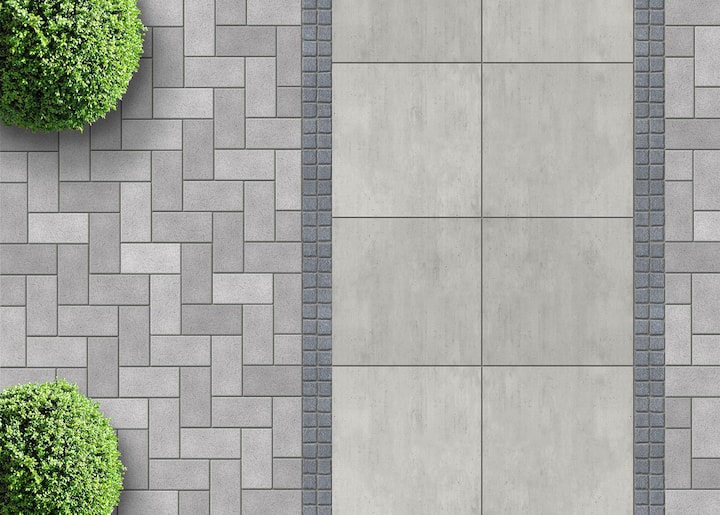
The Elegance of Interlocking Concrete Pavers
Interlocking concrete pavers are a popular choice for residential and commercial landscaping projects. These pavers are made from concrete and are designed to interlock, creating a durable and stable surface. They are commonly used for walkways, driveways, patios, and other outdoor areas.
One of the key benefits of interlocking concrete pavers is their versatility. They come in a wide range of colors, shapes, and sizes, allowing for endless design possibilities. Additionally, they are known for their durability and low maintenance requirements.
In this article, we will explore the definition and explanation of interlocking concrete pavers, the benefits of using them, the installation process, maintenance requirements, and how they compare to other paving materials.
Definition and Explanation of Interlocking Concrete Pavers
This section provides a clear and concise explanation of the definition and functionality of a commonly used hardscape material.
Interlocking concrete pavers are a type of precast concrete that interlock together to create a solid, durable surface. They are commonly used for driveways, walkways, patios, and other outdoor living spaces.
The interlocking design allows for flexibility and ease of installation, as the pavers can be easily removed and replaced if necessary. They are also resistant to cracking and can withstand heavy traffic and extreme weather conditions.
Interlocking concrete pavers come in a variety of shapes, sizes, and colors, making them a versatile choice for any landscape design.
Overall, interlocking concrete pavers offer a durable and aesthetically pleasing solution for any outdoor hardscaping project.
Benefits of Using Interlocking Concrete Pavers
The advantages of utilizing interlocking concrete pavers as a hardscaping material are numerous and include enhanced durability, aesthetic appeal, and ease of maintenance.
Concrete pavers are resistant to harsh weather conditions, heavy foot traffic, and even vehicular traffic. They can last for decades without showing any significant wear and tear, making them a cost-effective investment in the long run.
Additionally, interlocking pavers are available in a wide variety of colors, patterns, and textures, allowing for endless design possibilities that can complement any architectural style.
Maintenance is also relatively easy, as the individual pavers can be replaced without affecting the overall integrity of the structure.
All these benefits make interlocking concrete pavers a popular choice for homeowners, landscapers, and architects alike.
Installation Process
The installation process of interlocking concrete pavers involves several important steps that must be carefully executed to ensure a durable and aesthetically pleasing outcome. Firstly, the area where the pavers will be installed is excavated and leveled to provide a stable base.
Next, a layer of gravel is added and compacted to provide drainage and prevent settling. Then, a layer of sand is added and leveled to create a smooth surface for the pavers. The pavers are then carefully placed in the desired pattern, with each unit interlocking with its neighbors.
Finally, the joints between the pavers are filled with sand to stabilize the surface and prevent movement. Proper installation is crucial for the longevity and durability of interlocking concrete pavers, and it is recommended to hire a professional hardscaping contractor to ensure a successful outcome.
Maintenance Requirements
To ensure the longevity and aesthetic appeal of the paved surface, regular maintenance that includes cleaning of debris, removing weeds, and re-sanding the joints is required.
Interlocking concrete pavers are a durable and low-maintenance option for outdoor surfaces, but neglecting regular upkeep can lead to a build-up of dirt, debris, and weeds that can detract from their appearance and functionality.
Cleaning the surface with a pressure washer and sweeping regularly can help prevent build-up and keep the pavers looking new. Additionally, removing weeds by hand or using an herbicide can prevent the growth of unwanted plants between the joints.
Finally, re-sanding the joints with polymeric sand can ensure that the pavers remain stable and prevent water from seeping underneath, which can cause shifting and cracking.
By following these maintenance requirements, interlocking concrete pavers can remain a beautiful and functional addition to any outdoor space for years to come.
Comparison to Other Paving Materials
There is no denying that interlocking concrete pavers stand out when compared to other paving materials in terms of their durability, low-maintenance requirements, and aesthetic appeal.
When compared to poured concrete or asphalt, interlocking concrete pavers offer greater strength and durability, thanks to their interlocking design. This design also allows for better weight distribution, making them more resistant to cracking and shifting.
In addition, interlocking concrete pavers require little maintenance, as they can simply be swept or pressure washed to maintain their appearance. They also come in a variety of colors, shapes, and sizes, allowing for endless design possibilities that can enhance the aesthetic appeal of any outdoor space.
When compared to natural stone, interlocking concrete pavers are more affordable and can be easier to install, making them a practical choice for those looking to upgrade their outdoor space while staying within budget.
Overall, interlocking concrete pavers are the superior choice for those looking for a durable, low-maintenance, and visually appealing paving material.
Connect with Concrete experts near you
Need help with your next Concrete project? We’re here for you! Call us and we’ll put you in touch with experienced, reliable Concrete experts in Modesto, California.